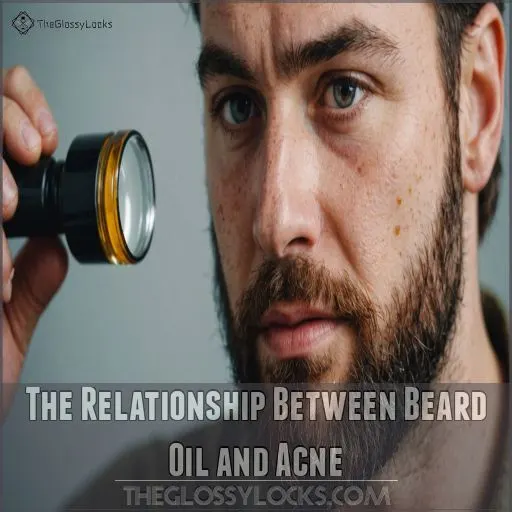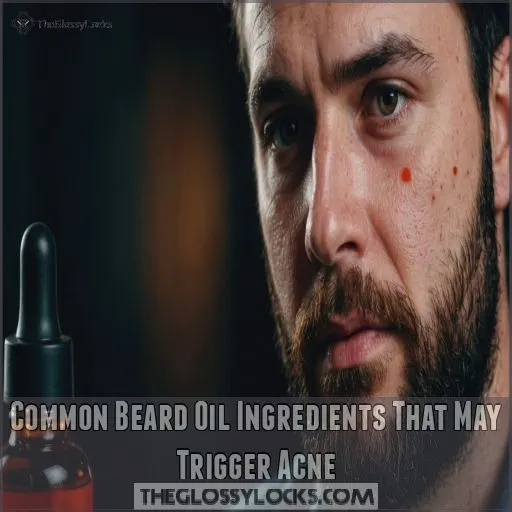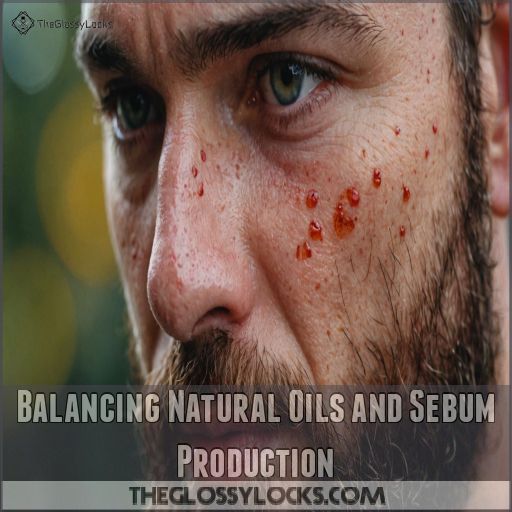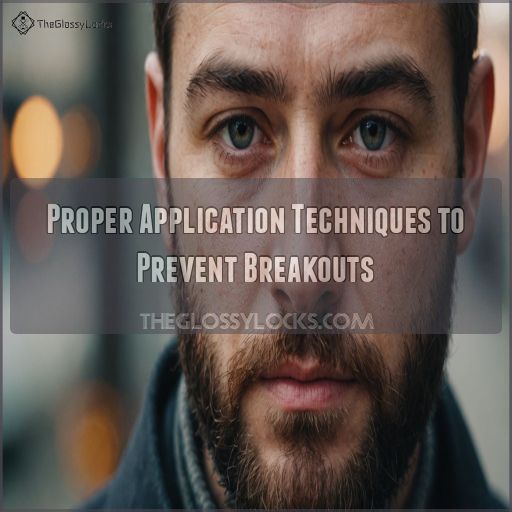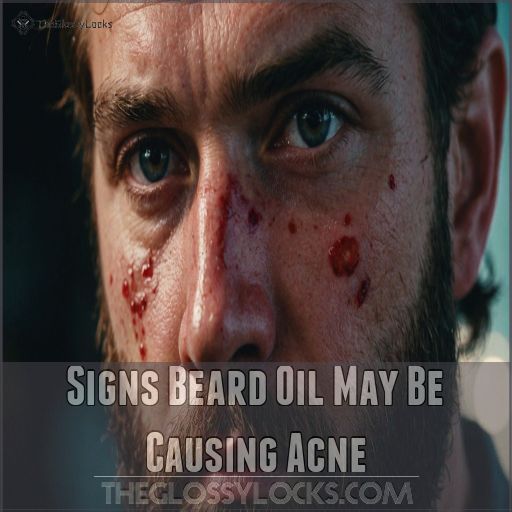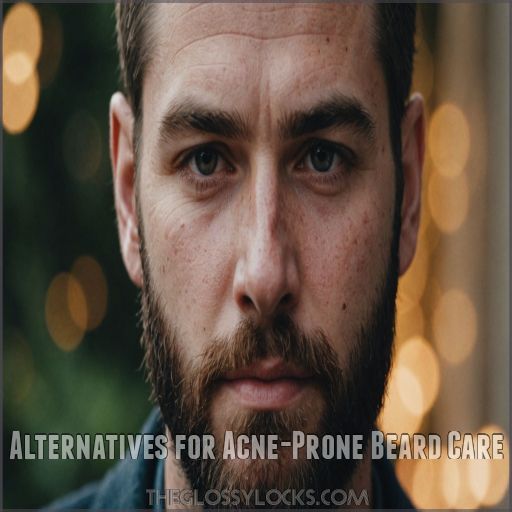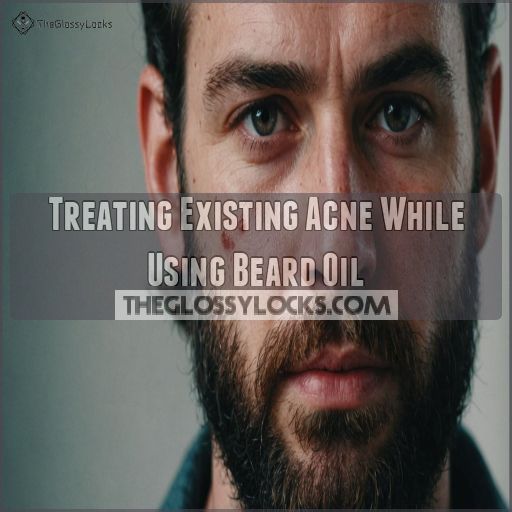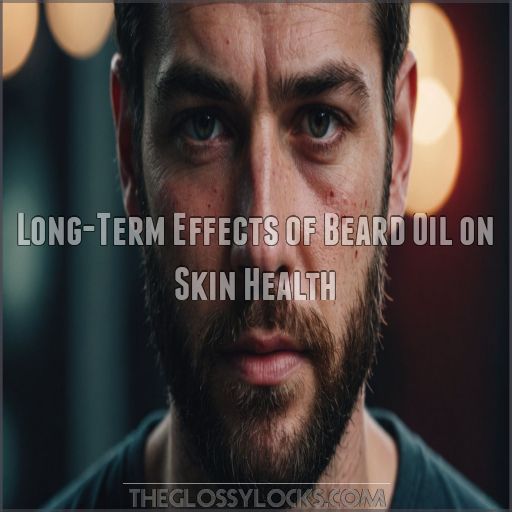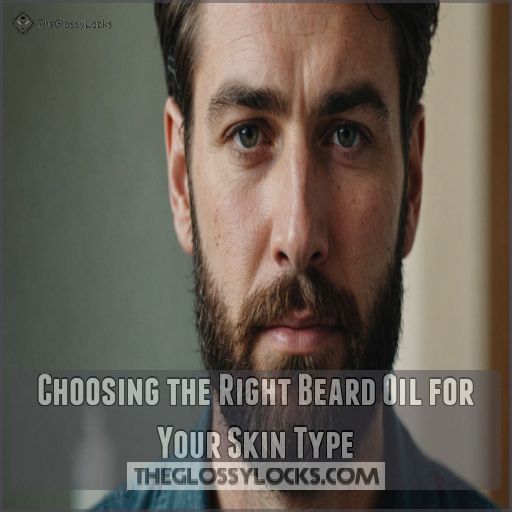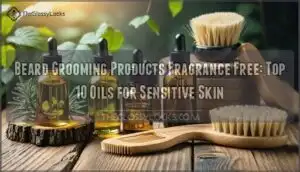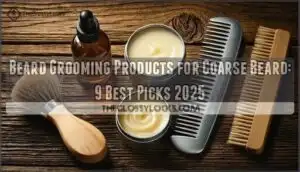This site is supported by our readers. We may earn a commission, at no cost to you, if you purchase through links.
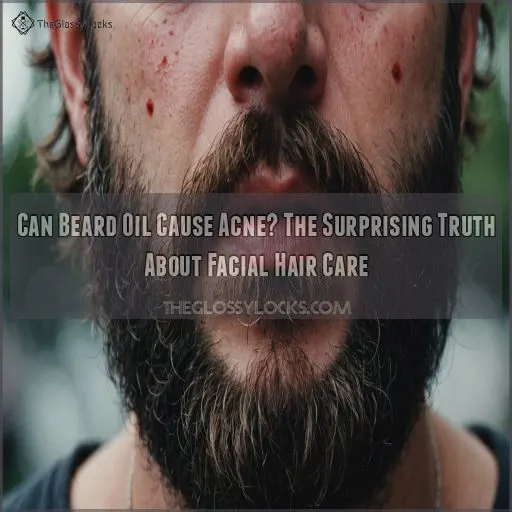 Yes, beard oil can cause acne, but it’s not a one-size-fits-all situation.
Yes, beard oil can cause acne, but it’s not a one-size-fits-all situation.
Your skin type and the ingredients in your beard oil play a huge role.
Some oils, like coconut and avocado, are comedogenic culprits that can clog pores faster than you can say "breakout."
On the flip side, non-comedogenic options like jojoba and argan oil can keep your beard soft without turning your face into a pimple playground, which you can learn more about in beard oil ingredients.
It’s all about finding the right balance and not overdoing it.
Think of beard oil like seasoning – a little goes a long way.
Stick around to learn which ingredients to avoid and how to keep your beard game strong without sacrificing clear skin.
Table Of Contents
- Key Takeaways
- The Relationship Between Beard Oil and Acne
- Common Beard Oil Ingredients That May Trigger Acne
- Non-Comedogenic Beard Oil Ingredients for Clear Skin
- Balancing Natural Oils and Sebum Production
- Proper Application Techniques to Prevent Breakouts
- Signs Beard Oil May Be Causing Acne
- Alternatives for Acne-Prone Beard Care
- Treating Existing Acne While Using Beard Oil
- Long-Term Effects of Beard Oil on Skin Health
- Choosing the Right Beard Oil for Your Skin Type
- Frequently Asked Questions (FAQs)
- What beard oil doesn’t cause acne?
- What are the negatives of beard oil?
- What happens if I use beard oil everyday?
- Is there any side effects of using beard oil?
- Can beard oil help with beard dandruff?
- How often should I wash my beard?
- Is beard oil suitable for sensitive skin?
- Can I make my own beard oil at home?
- Does beard oil affect beard growth or thickness?
- Conclusion
Key Takeaways
- You’re not imagining things – beard oil can indeed cause acne for some guys, especially if you’ve got oily or acne-prone skin. It’s like walking a tightrope between nourishing your facial hair and keeping your skin clear.
- Not all oils are created equal when it comes to your skin. Coconut and avocado oils might be great for cooking, but they are comedogenic culprits that can clog your pores faster than you can say "breakout." Stick to non-comedogenic options like jojoba or argan oil to keep your beard soft without turning your face into a pimple playground.
- Less is more when it comes to applying beard oil. Think of it like seasoning your food – a little goes a long way. Start with just a few drops every other day and adjust based on how your skin reacts. Your face isn’t an oil slick, after all!
- If you’re noticing new zits popping up in your beard area or your skin’s getting extra oily, your beloved beard oil might be the culprit. Don’t worry though – with some trial and error, you can find the right product and routine to keep both your beard and skin happy. It’s like finding the perfect dance partner for your face!
The Relationship Between Beard Oil and Acne
You might love your beard, but your skin might not be such a fan of your beard oil.
Let’s explore the surprising connection between beard oil and acne, and uncover the truth about which ingredients could be turning your facial hair care routine into a breakout nightmare.
Comedogenic Vs Non-Comedogenic Ingredients
When it comes to beard oil, not all ingredients are created equal.
You’ll want to know the difference between comedogenic and non-comedogenic components.
Comedogenic ingredients can clog your pores, while non-comedogenic ones won’t.
Understanding this distinction is essential for maintaining clear skin.
Pore-Clogging Potential of Beard Oils
Some beard oils can be real troublemakers for your skin.
Their pore-clogging potential depends on the ingredients and their comedogenic ratings.
You’ll want to watch out for oils that don’t play nice with your skin, potentially leading to unwanted breakouts.
Skin Type Considerations
Your skin type plays a huge role in how beard oil affects you.
Not all oils are created equal!
- Oily skin? Lightweight oils are your friend.
- Dry skin? Rich, moisturizing oils work wonders.
- Sensitive skin? Stick to gentle, non-irritating formulas.
Acne-Prone Skin and Beard Oil Use
With acne-prone skin, beard oil can be tricky.
It’s like walking a tightrope between nourishing your facial hair and avoiding breakouts.
The key? Choosing non-comedogenic ingredients and applying sparingly.
Don’t worry, though—with the right approach, you can rock that beard confidently.
Common Beard Oil Ingredients That May Trigger Acne
You might love your beard oil, but some common ingredients could be secretly sabotaging your skin.
Let’s uncover which popular beard oil components might be triggering those pesky breakouts, so you can keep your facial hair game strong without compromising your complexion.
Coconut Oil and Its Comedogenic Rating
Coconut oil might be your beard’s best friend, but it’s not always kind to your skin.
With a comedogenic rating of 4 out of 5, it’s a pore-clogging culprit that can spark unwanted breakouts.
Avocado Oil’s Impact on Acne-Prone Skin
Avocado oil’s impact on acne-prone skin isn’t black and white.
While it’s moisturizing, its high oleic acid content can spell trouble for some beards.
Let’s break down the pros and cons:
- Deeply nourishing for dry, brittle facial hair
- Rich in vitamins A, D, and E
- May exacerbate acne in oily skin types
- Has a moderate comedogenic rating of 3 out of 5
Soybean Oil and Pore Clogging
You might be surprised to learn that soybean oil, a common beard oil ingredient, can be a sneaky acne trigger.
It’s known for clogging pores, potentially turning your facial hair care routine into a breakout nightmare with the wrong ingredients.
Flaxseed Oil’s Effects on Facial Skin
While soybean oil’s pore-clogging potential raises eyebrows, flaxseed oil’s effects on facial skin are equally surprising. This common beard oil ingredient packs a punch:
- Gleaming droplets of amber liquid
- Nutty aroma wafting through the air
- Silky smooth texture on fingertips
- Tiny seeds crushed to release golden goodness
- Shimmering oil absorbing into bristles
Flaxseed oil is a common beard oil ingredient.
Marula Oil and Acne Concerns
Despite its moisturizing properties, marula oil can be a double-edged sword for your beard.
With a comedogenic rating of 3-4, it might clog pores and trigger breakouts.
Consider alternatives like jojoba oil for acne-prone skin.
Non-Comedogenic Beard Oil Ingredients for Clear Skin
If you’re struggling with acne but don’t want to give up your luscious beard, fear not.
Non-comedogenic beard oil ingredients can help you maintain a healthy, well-groomed beard without clogging your pores or triggering breakouts.
Argan Oil Benefits for Beards and Skin
Argan oil’s a game-changer for your beard and skin. This liquid gold nourishes follicles, promoting growth and softness.
It’s non-comedogenic, so you can kiss acne worries goodbye while enjoying hydrated, youthful-looking skin beneath your magnificent mane.
Jojoba Oil as a Sebum Mimic
Jojoba oil is your beard’s secret weapon. It’s like a chameleon, mimicking your skin’s natural sebum. This non-comedogenic marvel keeps your facial hair happy without clogging pores.
- Balances oil production
- Moisturizes without greasiness
- Reduces inflammation and irritation
Sweet Almond Oil for Beard Conditioning
You’ve heard about jojoba, but have you tried sweet almond oil?
It’s a non-comedogenic powerhouse that’ll condition your beard without clogging pores.
Plus, it’s packed with vitamin E for healthy skin and hair.
Tea Tree Oil’s Antibacterial Properties
Learn about tea tree oil, nature’s acne-fighting superhero.
This powerful essential oil packs a punch against bacteria, potentially reducing breakouts.
But remember, a little goes a long way—it can irritate sensitive skin.
Grapeseed Oil for Lightweight Moisturizing
Tea tree oil’s not for everyone. Enter grapeseed oil, your beard’s new best friend.
This lightweight marvel offers:
- Non-comedogenic properties
- Vitamin E for skin health
- Quick absorption
- Gentle moisturizing
- Neutral scent
It’s a game-changer for acne-prone skin!
Balancing Natural Oils and Sebum Production
You might think slathering your beard with oil is the key to luscious facial hair, but it’s not that simple. You can find top beard conditioners to help with that.
Understanding how beard oil interacts with your skin’s natural sebum production is key to keeping both your beard and face healthy and acne-free.
Understanding Skin’s Natural Oil Production
Your skin’s a natural oil factory, constantly producing sebum to protect and moisturize.
This delicate balance varies based on your unique skin type, pore size, and hydration levels.
Understanding your skin’s oil production is key to maintaining a healthy, acne-free complexion.
How Beard Oil Affects Sebum Balance
Beard oil can be a double-edged sword for your skin’s oil balance.
While it moisturizes and nourishes, it might also throw your natural sebum production into a tizzy.
Think of it as a delicate dance between hydration and potential pore-clogging chaos.
Optimal Oil Ratios for Acne-Prone Skin
Finding the sweet spot for oil ratios can make or break your beard game.
Experiment with different blends to find your perfect match.
Stick to a 1:3 ratio of essential oils to carrier oils for acne-prone skin.
This balance helps nourish your beard without overwhelming your pores.
Regulating Excess Oil With Proper Products
Managing excess oil isn’t just about slapping on any product.
To keep your face from turning into an oil slick, you’ll need the right arsenal.
Let’s explore how to choose products that’ll help you strike that perfect balance.
Proper Application Techniques to Prevent Breakouts
You might love your beard oil, but applying it correctly is key to avoiding breakouts. Let’s explore how to use beard oil without turning your face into a pimple party.
Cleansing Before Beard Oil Application
You’ve mastered balancing oils, now let’s tackle cleansing. Before applying beard oil, give your face a proper wash.
It’s like prepping a canvas before painting a masterpiece.
- Use lukewarm water to open pores
- Choose a gentle, pH-balanced cleanser
- Massage in circular motions for 30 seconds
- Rinse thoroughly, ensuring no soap residue
- Pat dry with a clean, soft towel
Correct Amount of Oil to Use
Goldilocks had it right—you want just the right amount of beard oil.
For most beards, 3-5 drops will do the trick.
Adjust based on your beard’s length and thickness, but don’t go overboard!
Even Distribution Throughout the Beard
Once you’ve got the right amount, it’s time to spread that liquid gold evenly.
- Massage like you’re petting a kitten
- Comb it through for silky smoothness
- Reach those hard-to-get spots
Frequency of Application for Acne-Prone Skin
When dealing with acne-prone skin, less is more.
Start by applying beard oil every other day or even every third day.
Adjust based on how your skin responds, keeping an eye out for any breakouts.
Avoiding Over-Application and Residue Build-up
Less is more with beard oil.
You don’t want to look like you’ve dipped your face in a fryer!
Apply sparingly and massage thoroughly to avoid greasy build-up that can clog pores.
Signs Beard Oil May Be Causing Acne
While beard oil can work wonders for your facial hair, it might be causing some unwanted side effects on your skin.
If you’re noticing new breakouts, increased oiliness, or irritation in your beard area, your beloved beard oil could be the culprit.
New Breakouts in Beard Area
You’ve applied beard oil correctly, but new zits pop up in your facial hair. What gives? This could be your product rebelling against your skin.
Keep an eye out for these uninvited guests—they’re often the first sign of trouble brewing.
Increased Oiliness of Skin
After applying beard oil, your skin might feel like an oil slick.
If you’re noticing a shiny, greasy appearance or your face feels slippery to the touch, it’s a red flag.
Your skin’s natural oil balance may be out of whack.
Clogged Pores and Blackheads
You’re noticing tiny black dots or bumps in your beard area?
Those pesky blackheads might be your beard oil’s calling card.
When pores get clogged, it’s like a traffic jam on your face.
Time to play detective with your grooming routine!
Skin Irritation and Redness
In addition to clogged pores, your beard oil might be causing trouble if you notice skin irritation and redness.
Watch out for these telltale signs:
- A burning or stinging sensation
- Itchy, inflamed skin
- Rash-like appearance in your beard area
Alternatives for Acne-Prone Beard Care
If you’re struggling with acne but still want to keep your beard looking its best, don’t worry – there are alternatives to traditional beard oils.
Acne-friendly options will help you maintain a healthy, well-groomed beard without sacrificing your skin’s clarity.
Water-Based Beard Moisturizers
If beard oil isn’t your jam, don’t sweat it!
Water-based beard moisturizers are your acne-fighting sidekick.
They’re like a cool drink for your facial hair, hydrating without the heavy feeling.
Plus, they’re less likely to clog those precious pores.
Lightweight Beard Serums
Lightweight beard serums are your acne-prone skin’s new best friend.
These water-based wonders offer:
- Quick absorption without clogging pores
- Targeted nourishment for hair and skin
- Easy application that won’t leave you feeling greasy
Say goodbye to breakouts and hello to a happier beard!
Natural Beard Balms With Non-Comedogenic Ingredients
Nature’s beard-taming secret? Natural beard balms with non-comedogenic ingredients offer a fantastic alternative for your acne-prone skin.
These balms provide moisture and hold without clogging pores.
You’ll find options packed with skin-friendly ingredients like shea butter, beeswax, and jojoba oil.
Say goodbye to breakouts!
DIY Acne-Safe Beard Oil Recipes
Natural beard balms are great, but you can’t beat a custom blend. Whip up your own acne-safe beard oil with these simple recipes:
- Jojoba base with tea tree kick
- Grapeseed-argan combo for silky smooth
- Light almond oil infused with lavender
You’re in control, beard boss!
Treating Existing Acne While Using Beard Oil
If you’re battling acne while rocking a beard, don’t worry – you can have the best of both worlds.
With the right approach, you can treat existing breakouts and maintain your facial hair without sacrificing clear skin or a well-groomed beard.
Incorporating Salicylic Acid Products
While exploring alternatives is great, don’t forget about salicylic acid. This powerhouse ingredient can be your bearded ally against acne.
Incorporate it into your routine with a gentle face wash or toner.
You’ll be amazed at how it unclogs pores and fights breakouts.
Using Benzoyl Peroxide for Spot Treatment
Tackle stubborn acne with benzoyl peroxide spot treatments while using beard oil. Here’s your game plan:
- Choose a 2.5% concentration
- Apply a small dab directly on pimples
- Use once daily, preferably at night
Avoid getting it on your beard hair
- Avoid getting it on your beard hair
Gentle Exfoliation Techniques for Bearded Skin
Gently exfoliating your bearded skin is key to fighting acne without irritation.
You’ll want to use soft-bristled brushes or mild scrubs with ingredients like jojoba beads.
Don’t overdo it – once or twice a week is plenty for most guys with sensitive skin.
Importance of Consistent Cleansing Routine
Exfoliating your beard is just the first step. You’ll want to establish a rock-solid cleansing routine to keep acne at bay.
- Wash away the day’s grime
- Banish pesky bacteria
- Hydrate your skin fortress
- Arm yourself with beard oil
Long-Term Effects of Beard Oil on Skin Health
You might be wondering about the long-term impact of beard oil on your skin’s health.
While regular use can potentially improve your skin’s barrier function, it’s important to think about how it might affect your pores and skin microbiome over time.
Potential for Improved Skin Barrier Function
While treating acne, you might worry about using beard oil. But here’s a silver lining: quality beard oils can actually boost your skin’s barrier function over time.
They’ll keep your face hydrated, potentially leading to a healthier skin microbiome and improved overall complexion.
Risk of Chronic Pore Congestion
With improved skin barrier function, you’re not out of the woods yet. Chronic pore congestion can still lurk if you’re not careful. Here’s what you need to know:
- Oil buildup over time
- Trapped dead skin cells
- Slow-forming blackheads
- Gradual skin texture changes
Changes in Skin Microbiome
Your beard oil might be a secret ally for your skin’s tiny inhabitants.
It can alter your facial microbiome, potentially boosting beneficial bacteria.
This microscopic makeover could lead to a healthier complexion, but remember: everyone’s skin ecosystem is unique.
Impact on Long-Term Acne Management
Moving beyond microbiome changes, let’s tackle the big picture.
Consistent beard oil use can be a game-changer for long-term acne management.
It’s like training your skin – you’re building a stronger barrier, regulating oil production, and finding that sweet spot for clear, healthy skin.
Choosing the Right Beard Oil for Your Skin Type
Choosing the right beard oil for your skin type can make or break your facial hair game.
You’ll want to think about your skin’s unique needs and sensitivities to find a formula that keeps your beard looking great without causing unwanted breakouts.
Assessing Individual Skin Sensitivity
Thinking about trying beard oils? It’s important to figure out how sensitive your skin is. Here’s how to pinpoint your sensitivity level:
- Take a skin type quiz for personalized insights
- Review your allergy history, noting past reactions
- Evaluate your facial oil tolerance from previous products
- Scrutinize product ingredients, flagging potential irritants
Don’t worry, you’ve got this!
Patch Testing New Beard Oil Products
Before slathering that new beard oil all over, it’s wise to patch test.
| Test Area | What to Look For | Day 1-2 | Day 3-7 |
|---|---|---|---|
| Inner elbow | Redness or itching | Apply a small amount | Monitor for reactions |
| Behind ear | Bumps or swelling | Reapply if no issues | Continue observation |
This simple step can save your skin from potential irritation or breakouts.
Consulting With Dermatologists for Personalized Advice
While patch testing is helpful, nothing beats expert guidance.
Your dermatologist can be your beard’s best friend, offering advice specific to your unique skin type and concerns.
They’ll help you navigate the sea of beard oils, pinpoint potential acne triggers, and craft a personalized skincare routine that keeps your facial hair and skin happy.
Frequently Asked Questions (FAQs)
What beard oil doesn’t cause acne?
Worried about breakouts? You’re not alone.
Opt for non-comedogenic beard oils with jojoba or argan oil.
They’ll keep your beard soft without clogging pores.
Remember, less is more – start with a few drops every other day.
What are the negatives of beard oil?
You might face skin irritation, clogged pores, or allergic reactions from certain beard oils.
They can be greasy, leave residue, and potentially worsen acne.
Some oils may also stain clothes or pillowcases if not fully absorbed.
What happens if I use beard oil everyday?
Using beard oil daily can keep your facial hair soft and skin moisturized, especially if you choose a product with natural ingredients like jojoba oil.
However, it might lead to clogged pores if you’re acne-prone.
Try every other day to start, and adjust based on how your skin responds.
Is there any side effects of using beard oil?
While beard oil can work wonders, it’s not without potential pitfalls.
Possible side effects include skin irritation, clogged pores, and allergic reactions.
Don’t worry though – with the right product and application, you’ll be rocking that healthy beard!
Can beard oil help with beard dandruff?
Could beard oil banish those pesky flakes? Indeed, it can!
Beard oil moisturizes dry skin, reducing dandruff.
It’s packed with nourishing ingredients that soothe irritation and keep your facial hair healthy.
Give it a try – your beard will thank you!
How often should I wash my beard?
You’ll want to wash your beard 2-3 times a week, depending on your lifestyle and skin type.
Don’t overdo it, or you’ll strip natural oils!
Experiment to find your sweet spot for a clean, healthy beard.
Is beard oil suitable for sensitive skin?
Like a gentle caress for your face, beard oil can be your sensitive skin‘s best friend, but you might be wondering about the potential for acne.
It’s all about choosing the right ingredients.
Non-comedogenic oils like argan and jojoba are your go-to allies for a happy, healthy beard.
Can I make my own beard oil at home?
Making your own beard oil is a breeze.
Mix carrier oils like jojoba or argan with a few drops of essential oils for fragrance.
It’s like crafting a custom potion for your facial fuzz – fun and effective!
Does beard oil affect beard growth or thickness?
Ironically, beard oil won’t magically transform you into a lumberjack overnight.
It doesn’t directly affect growth or thickness, but it can make your beard look fuller by moisturizing and conditioning.
Think of it as pampering, not a miracle potion.
Conclusion
Choosing the right beard oil can feel like defusing a ticking acne bomb, but it doesn’t have to be that way.
Remember, can beard oil cause acne? Absolutely, but it’s all about choosing wisely.
Opt for non-comedogenic oils like jojoba or argan, and apply sparingly.
Listen to your skin – if it’s rebelling, switch things up.
With the right approach, you can rock a luscious beard and clear skin.
So go forth, bearded warriors, and conquer facial hair care with confidence!

